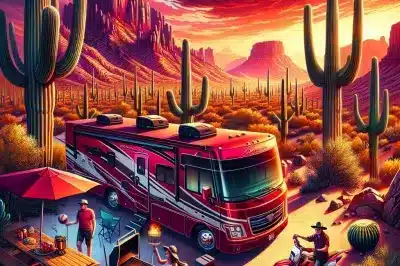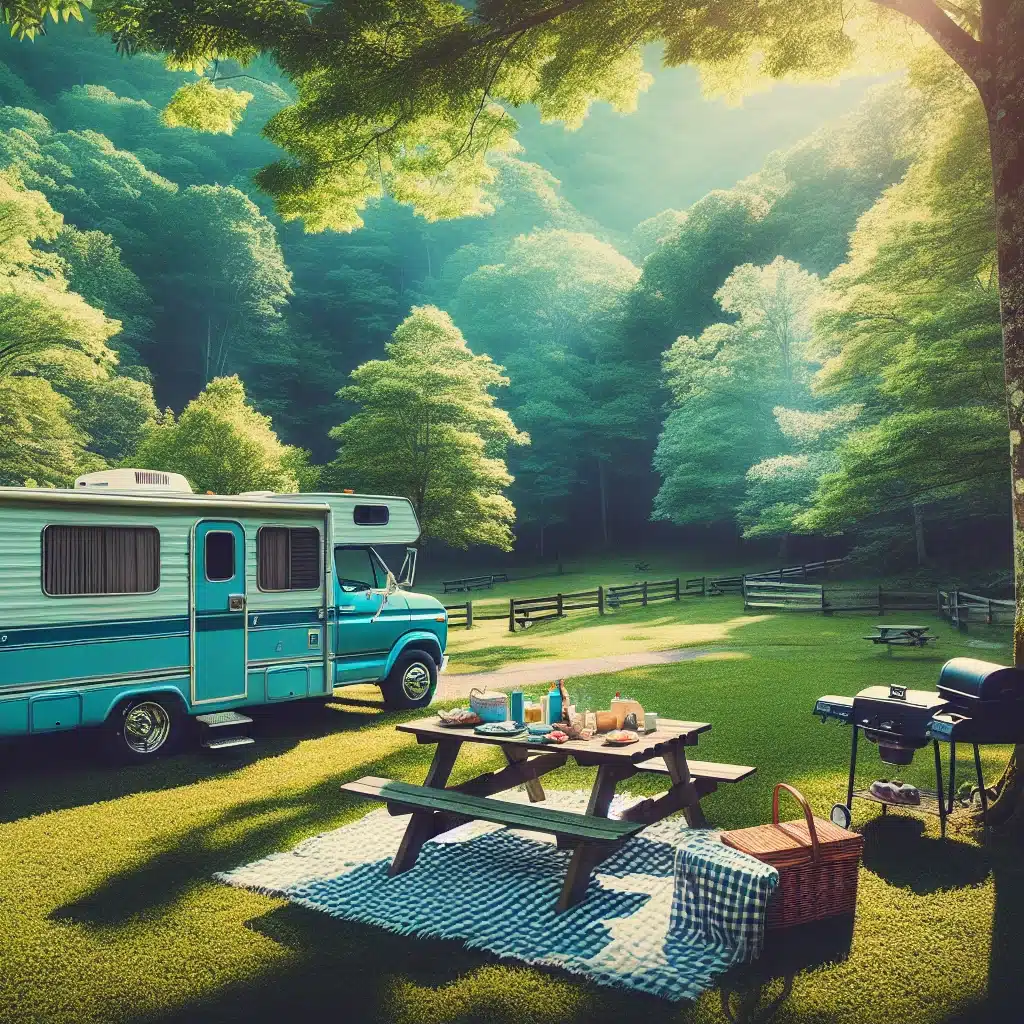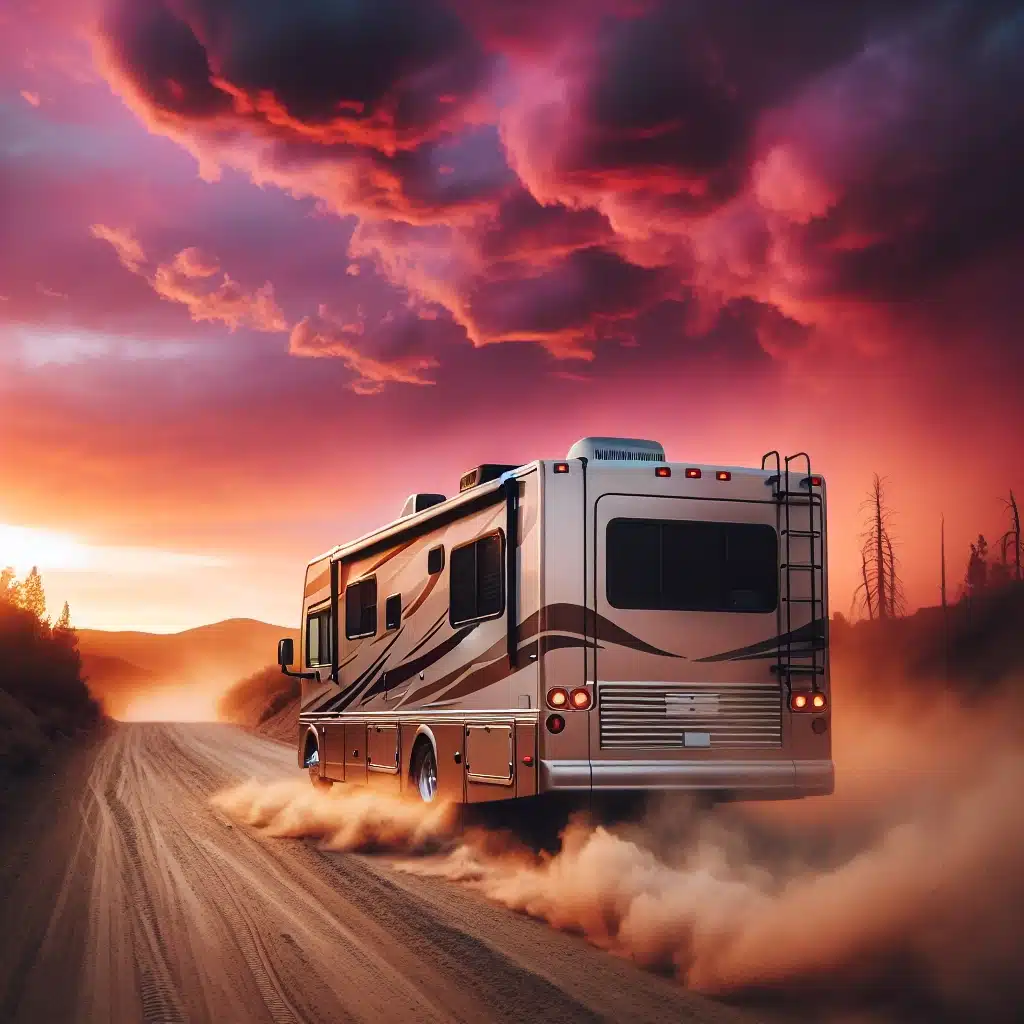Table of Contents

Shining Light on Solar: Powering Your RV Off-Grid
Imagine the freedom of traveling with your home on wheels, parking in the most scenic spots, and not needing a power hook-up. That’s the beauty of harnessing solar energy for your RV. It’s a game-changer for boondocking, where you camp without any hookups at all. And don’t worry, you don’t need to be a tech wizard to get started. Let’s explore how solar power can keep your lights on and your adventures rolling.
Why Solar? The Advantages for Boondocking Beginners
Choosing solar power for your RV isn’t just about being eco-friendly. It’s about independence and convenience. Here’s why solar is a smart choice for boondocking newbies:
- No more searching for campsites with electrical hookups.
- Say goodbye to the noise and fumes of a generator.
- Enjoy the cost savings over time compared to non-renewable energy sources.
- Take pride in reducing your carbon footprint.
- Experience the peace of mind that comes with a reliable power source.
With solar panels on your RV, the sun’s energy becomes your ticket to off-grid freedom.
Solar Power 101: Understanding the Basics
Solar power for an RV might seem complex, but it boils down to capturing sunlight and converting it into electricity. This electricity then charges your RV batteries, which power everything from your lights to your fridge. The key is to have a system that matches your energy needs. So, let’s break down the basics:
The Essential Components of a Solar Setup
Your solar setup is like a mini power plant on your RV’s roof. At its core, you’ll find:
- Solar panels: These are the workhorses, soaking up sunlight.
- Charge controller: It’s the brain, ensuring your batteries charge correctly without overcharging.
- Batteries: They’re the storage units, holding onto that power until you need it.
- Inverter: This gadget turns the stored power into usable electricity for your appliances.
Each component is crucial, and understanding how they work together is the first step toward solar success.
Finding Your Solar Sweet Spot: How Much Power Do You Really Need?
Before you start buying solar panels, you need to know how much power you’ll use. It’s not a one-size-fits-all situation. Your power needs depend on how you use your RV. Do you need to power a laptop and lights, or are you looking to run an air conditioner? Let’s figure out your energy needs to build the perfect solar setup.
Calculating Your Energy Consumption
Start by making a list of all the electrical devices you use in your RV. For each item, note how much power it uses (in watts) and how long you use it each day. Add up the daily watt-hours for all your devices, and you’ve got a rough estimate of your daily energy consumption. This number is your guide to choosing the right solar system size.
Estimating Solar Panel Needs Based on Lifestyle
Your RV lifestyle plays a big role in determining how many solar panels you’ll need. If you’re a weekend warrior, your needs will differ from someone living full-time in their RV. Consider the season and location, too, as sunlight availability changes. A system that’s perfect for summer in the sunny Southwest might not cut it for a rainy Pacific Northwest winter.
Battery Bank Sizing: A Balancing Act
Your battery bank is like a water tank for electricity. Too small, and you’ll run out of power quickly. Too large, and you’re carrying around extra weight and expense. The goal is to have enough storage to get you through your longest anticipated period without sunshine, while also fitting within your budget and space constraints.
Calculating your energy consumption, estimating your solar panel needs, and sizing your battery bank are all critical steps in setting up your off-grid solar system. These steps ensure that you have a reliable source of power that meets your specific needs, without overinvesting in unnecessary equipment.

Navigating the Tech: Picking the Right Solar Equipment
With your energy needs in hand, it’s time to dive into the tech side of things. Picking the right solar equipment is crucial for a system that’s efficient, durable, and right for your RV lifestyle. Let’s talk about how to choose the best solar panels, charge controllers, and inverters for your off-grid adventures.
Choosing Solar Panels: Types and Efficiency
Solar panels come in different shapes and sizes, each with their own efficiency levels. Here’s the lowdown:
- Monocrystalline: High efficiency and durability, ideal for limited space.
- Polycrystalline: Slightly lower efficiency, but often more affordable.
- Thin-film: Flexible and lightweight, but requires more space for the same output.
Pick panels that balance efficiency with your available roof space and budget. Remember, higher efficiency means more power from less space, but it’ll cost you a bit more upfront.
Charge Controllers: PWM vs. MPPT
Charge controllers protect your batteries from being overcharged by your solar panels. There are two main types:
- PWM (Pulse Width Modulation): These are simpler and usually cheaper, but less efficient.
- MPPT (Maximum Power Point Tracking): More expensive, but squeeze up to 30% more efficiency out of your panels.
If budget allows, go for an MPPT controller. It’ll maximize your solar investment, especially in varied weather conditions.
Power Inverters: Sine Wave Considerations
Inverters turn the DC power stored in your batteries into AC power for your appliances. Here’s what to consider:
- Modified Sine Wave: Cheaper, but can be noisy and less efficient.
- Pure Sine Wave: Mimics the power from the grid, better for sensitive electronics.
For a smooth operation of all your gadgets, a pure sine wave inverter is the way to go.
Monitoring and Maintenance Tools
Keeping an eye on your system’s health is key to longevity. Invest in a good monitoring system to track:
- Battery voltage and state of charge.
- Solar panel output.
- Energy consumption.
Regular maintenance checks will also help you catch issues before they become problems, ensuring your system runs smoothly for years to come.
Installation Insights: Setting Up Your Solar System Step by Step
Now, let’s get your hands dirty. Setting up your solar system might seem daunting, but with the right approach, it’s a rewarding DIY project. We’ll cover the basics to get you started on the right foot.
Prepping Your RV for Solar
First things first, you’ll need to prep your RV. This means:
- Cleaning the roof and identifying the best spots for your panels.
- Planning the pathway for your wiring from the roof to your battery bank.
- Ensuring your battery bank has a secure and ventilated space.
Take your time with this step. Proper placement and wiring can make or break your system’s efficiency.
Mounting Panels and Running Wires
Mounting your panels securely is crucial, as they’ll face high winds and rough weather. Here’s how to do it right:
- Use mounting brackets designed for your specific RV roof type.
- Seal all entry points to prevent leaks.
- Run wires through conduit for protection and neatness.
Once your panels are in place and your wires are run, you’re on your way to solar-powered freedom. Just a few more steps and you’ll be soaking up the sun’s energy, no matter where your travels take you.
Configuring Charge Controllers and Batteries
Configuring your charge controller and batteries is like setting the rhythm for a dance between the sun, your panels, and your power needs. Connect your charge controller to the battery bank following the manufacturer’s instructions. Ensure the settings on the controller match the type of batteries you have, whether they’re lead-acid or lithium. This step is crucial for the health and efficiency of your batteries, as it prevents overcharging and maximizes their lifespan.
Final Check: Testing Your Setup
Before you hit the road, it’s vital to test your setup. Turn on your charge controller and check if it’s properly charging your batteries. Then, power up your inverter and try running your appliances. This is the moment of truth, where you’ll see your solar setup come to life. If everything is running smoothly, you’re ready to enjoy the off-grid lifestyle. If not, troubleshoot any issues now, while you still have easy access to tools and resources.

Optimizing and Maintaining Your Off-Grid Solar System
Getting your solar system up and running is just the beginning. To get the most out of your investment, you’ll want to optimize and maintain it regularly. This ensures your system operates at peak performance and can save you from unexpected hiccups down the road.
Maximizing Sun Exposure: Positioning and Angles
Maximizing sun exposure is key to efficient solar power generation. Park your RV so that your panels get direct sunlight, especially during peak sun hours. If you have adjustable mounts, tilt your panels towards the sun to catch those rays head-on. The optimal angle varies with the seasons and your geographical location, but a good rule of thumb is to set the angle equal to your latitude during summer and add 15 degrees in winter.
Battery Care and Lifespan Extension
Batteries are the backbone of your solar system, and they need love too. To extend their lifespan:
- Avoid deep discharges; try to keep your battery above 50% capacity.
- Perform regular check-ups, looking for corrosion or loose connections.
- Equalize lead-acid batteries periodically, if recommended by the manufacturer.
- Keep them at a moderate temperature, as extremes can shorten their life.
With proper care, your batteries will keep you powered up for many adventures to come.
System Monitoring and Troubleshooting
Stay ahead of the game by keeping an eye on your system’s performance. Use a monitoring system to track energy production, consumption, and battery health. If you notice any dips in performance, check your connections, clean your panels, and make sure your batteries are in good shape. Early detection of issues can prevent bigger problems and keep your system running smoothly.
Expandability and Upgrades: Future-Proofing Your Solar Setup
Your energy needs might change as you add new gadgets or spend more time off-grid. That’s why it’s smart to design your system with expandability in mind. Here’s how to keep your options open for future upgrades:
When to Consider Expanding Your Solar Array
If you find yourself consistently running out of power or if you’re planning to add more energy-hungry appliances, it might be time to expand your solar array. Before you do, reassess your energy consumption and consider the most efficient way to meet your increased needs. Adding panels is often the first step, but you might also need to upgrade your charge controller or battery bank to handle the extra capacity.
By configuring your system correctly, performing regular checks, and staying on top of maintenance, you can ensure that your solar setup not only meets your current needs but is also ready for any future expansions. This proactive approach will help you enjoy a reliable and efficient off-grid power source, making your RV adventures all the more enjoyable.
Adding Storage: Upgrading Your Battery Bank
Upgrading your battery bank is like giving your RV a deeper well to draw energy from. If you’re adding more panels or finding your current setup isn’t lasting as long as you’d like, it’s time to consider more storage. Look for batteries that match your existing setup in terms of type and voltage, and make sure your charge controller and inverter can handle the increased capacity. More storage means more freedom to use your appliances and gadgets without constantly watching the battery meter.
Integrating New Technologies
The world of solar power is always advancing, and staying updated can boost your system’s efficiency. From more efficient solar panels to battery advancements like lithium-ion technology, integrating new tech can mean more power, less weight, and longer life for your system. Keep an eye on the market and don’t be afraid to upgrade components that will offer significant benefits for your off-grid lifestyle.
Case in Solar Efficiency: Real RVers’ Off-Grid Success Stories
Nothing beats real-world examples to show the potential of solar power for RVs. Across the country, RVers are discovering the joys of off-grid living with the help of the sun. Let’s dive into some success stories that illustrate the transformative power of solar.
From Novice to Solar Pro: Firsthand Experiences
Take Mark and Sarah, who started with a simple setup of a couple of panels and a modest battery bank. Over time, as they became more confident boondockers, they expanded their system. Now, with a full array of high-efficiency panels and a beefed-up battery bank, they power their full-time RV life, including air conditioning, with ease. Their journey from solar novices to pros shows that with the right approach, anyone can achieve energy independence on the road.
Lessons Learned: Tips from the Solar Community
- Start small and scale up as you learn your actual power needs.
- Regular cleaning of solar panels can significantly boost efficiency.
- Invest in a good monitoring system to keep track of your energy usage.
- Consider the weight and balance of your RV when adding more batteries.
- Always have a backup plan, like a portable generator, for extended cloudy periods.
These nuggets of wisdom come from those who’ve been on the solar journey and can help you avoid common pitfalls.
Key Takeaways
Embracing solar power for your RV is a journey towards freedom and sustainability. Remember:
- Calculate your energy needs to design a system that’s just right for you.
- Quality components are worth the investment for reliability and efficiency.
- Regular maintenance and monitoring will keep your system in top shape.
- Upgrading your battery bank can extend your off-grid capabilities.
- Staying open to new technologies can bring significant benefits to your setup.
With these takeaways in mind, you’re well on your way to a successful off-grid solar experience.
Frequently Asked Questions (FAQ)
Can I power my entire RV off solar energy?
Yes, you absolutely can power your entire RV off solar energy, but it requires careful planning and investment. The key is to understand your energy needs and design a system that can meet those needs consistently. For full-time RVers or those with high power demands, a robust solar panel array and a sizable battery bank are essential. Remember, the sun isn’t always shining, so having enough storage to get through those cloudy days is crucial.
How do I determine the size of the solar setup I need?
Determining the size of your solar setup is all about understanding your energy needs. Start by listing all your appliances and how much power they consume. Next, estimate how many hours a day you use each appliance. Multiply the wattage by the hours used to get watt-hours per day. Add up the watt-hours for all appliances, and you’ll have your daily energy usage. With this number, you can work out how many solar panels and how much battery storage you’ll need to cover your energy consumption.
Is it difficult to install solar panels on an RV?
Installing solar panels on an RV can be a straightforward process, especially if you’re handy and comfortable with basic DIY tasks. Most solar kits come with clear instructions and all the necessary hardware. The key steps involve mounting the panels securely, wiring them to a charge controller, and connecting the system to your battery bank. If you’re not confident in doing this yourself, professional installation is always an option. Either way, the effort is well worth the freedom you’ll gain.
What maintenance does an RV solar system require?
Maintenance for an RV solar system is relatively minimal but important. Regularly clean your solar panels to ensure they’re operating efficiently. Check the connections and wiring for signs of wear or damage. Keep an eye on your battery levels and ensure they’re not being overcharged or discharged too deeply. Periodically inspect the mounting hardware to ensure everything is secure. With these simple steps, your solar system should serve you well for many years.
In conclusion, adopting off-grid solar solutions for your RV is a rewarding endeavor that brings independence, eco-friendliness, and cost savings. By understanding your energy needs, you can tailor a solar setup that’s perfect for your boondocking adventures. Installation can be a fun DIY project or a professional task, depending on your comfort level. Maintenance is straightforward, ensuring your system runs smoothly. And remember, your solar setup can grow with you, adapting to your changing needs. With the sun as your partner, the open road awaits, free from the constraints of traditional campgrounds. Embrace the solar-powered journey and enjoy the boundless freedom it brings to your RV lifestyle.
- Boondocking RVs: Flexible Solar Solutions – 3 March 2024
- Renewable Energy Tips for Full-Time Boondocking RVers – 2 March 2024
- Boondocking Solar Power Systems: Sizing Options & Solutions for Motorhomes – 1 March 2024
